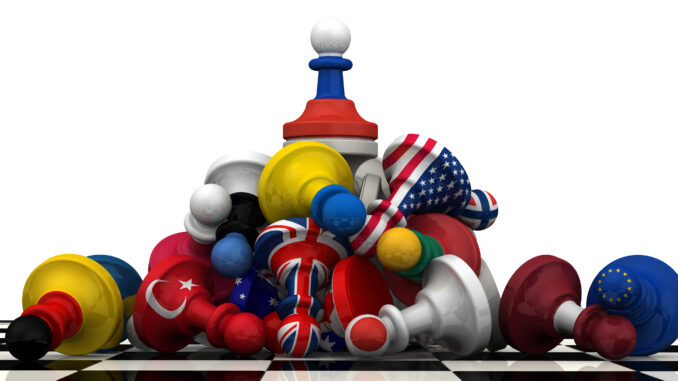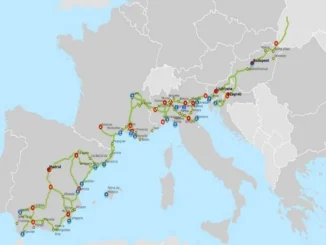
George McMillan III, Copyright © December 16, 2023 / September 14, 2024
Overt and Covert Entities and Strategic Planning
The purpose of this series of articles is twofold: first, to explain the role of energy in geopolitics to energy sector analysts, and second, this process explains the rationale of American Foreign policy in the post 9/11 Global War on Terror (GWOT) era which is pertinent to those Americans who were deployed overseas and are puzzled by the chaotic withdrawal from Afghanistan and the pivot to Ukraine.
The premise is that the more one understands the history of post-Mahan ‘sea power versus sea power’ and post-Mackinder ‘sea power versus land power’ geopolitical strategies, the more one will understand the underlying reasons for the continual conflict zones of Eastern Europe and every single area of the post-colonial Eurasian perimeter, namely Pakistan, Bangladesh and Myanmar.
That includes the invasion of Afghanistan and Iraq, as well as the “seven countries in five years” (Afghanistan plus Iraq, Syria, Lebanon, Libya, Somalia, Sudan, and Iran) that retired General Wesley Clark discussed with Amy Goodman on “Democracy Now!” and on other shows during his 2007 presidential campaign.
Clark explained the “eight countries in five years” strategy of the Cheney, Rumsfeld, Wolfowitz, Abrams, Talbot, Kristol, and Kagan branch of neoconservatives concluding that there had been a “foreign policy coup” in the US and that such an aggressive foreign policy program needs to be explained and discussed in a democratic forum if the US was indeed a representative Democratic Republic.
Since it is not the place of the more discrete government agencies of any country to disclose their strategic plans, intentions, and counter strategies, it is the domain of academicians, journalists, and private sector analysts to investigate and speculate about the underlying purposes of domestic and foreign policies if the promotion of “Democratic ideals” was the actual goal of American foreign policy.
Two Decades of GWOT
Now that the West is over two decades into the GWOT more than enough time has passed to perform a longitudinal assessment of the prevailing fact patterns that have emerged—(a) everyone could see that the countries that the US invaded had immense oil, natural gas, and mineral reserves, (b) the US is advancing the EU and NATO everywhere along the Russian border, (c) the US has involved itself into Afghanistan and Central Asia following the “five industrial power center” and “rimland” strategies in an attempt to disrupt Russian and Chinese overland logistical infrastructural integration projects, which (d) equates with advancing the geopolitical thought lineage of Mahan, Mackinder, Spykman, Kennan, Brzezinski, Wolfowitz, Kristol and Kagan.
In particular, the US was advancing the “five industrial power center doctrine of Kennan’s “long telegram” sent from Moscow in 1947 and his “X” article published in Foreign Affairs in 1950. It is easy to see that the US has been expanding the EU Eastward with Office of Security Cooperation-Europe (OSC-E) riders directing member countries to adopt NATO military training standards. The various EU agreements with Central and Eastern European countries were NATO membership roadmaps required to further implement the evolving strategies of containment.
It was evident that NATO and the US Navy were and are positioning themselves to thwart all Russian and Chinese infrastructural and logistical projects that would turn the “production” of raw materials into “wealth” by delivering them to international customers in exchange for manufacturing process and consumer process technological tools and know-how.
Geopolitical Sea Power Versus Land Power Strategies
Post-Mahan ‘sea power versus sea power’ geopolitical thought in its basic elements is to devise the best strategy for a country to block a “seller” from its “customers” or a “supplier” from its “consumers.” For example, the Kingdom of Saudi Arabia has “wealth” because it can sell its petroleum products abroad in exchange for (1) construction companies to build first-rate office and living structures, sanitation, communication, and transportation infrastructures, that in turn (2) support modern appliances and vehicles that combine to make life much easier. A country needs to sell its “production” to gain “wealth” to fuel an economic development model that raises the mean, median, and modal measures of “living standards” of a country.
It is from this vantage point that the more one understands the history of geopolitical thought in conjunction with political and economic development theory that one can see Kennan’s original Five Industrial Power Center Strategy of reviving Western Europe in the 1950s and moving NATO to the Warsaw Pact border to contain Soviet era expansion has led to the steady expansion of NATO Eastward to the border of the Russian Federation and Belrus after the Soviet Union collapsed in the early 1990s. The goal of this is to further disintegrate the Russian Federation into a myriad of Republics to reroute the Caspian Sea and Ural oil and natural gas to Europe, which also requires regime change in Iran to complete the pipeline infrastructure to Turkey and Armenia.
An oil and natural gas pipeline analysis explains a very wide range of US Foreign policy behavior over the past three decades beginning with the George Herbert Walker Bush administration’s promise not to move NATO “one inch East” of the Oder River, but then moving the EU/NATO eastward during the Clinton administration. The subsequent administrations followed suit.
What has occurred is that the Anglosphere has continued the three-hundred-year tradition to (1) blockade Russia’s only three ports of St. Petersburg in the Baltic Sea, Crimea in the Black Sea, and Vladivostok in the Sea of Japan; (2) blockade all Russian pipelines to prevent an export-led growth strategy to fuel an economic development strategy of Russia, as (3) arms Ukraine and increases military aid to Stepan Bandera enthusiasts to increase military pressure in Eastern Ukraine against Russian speaking population of that region, followed by (4) an increase in US economic and financial sanctions against Russia to forestall oil and natural gas sales to Europe, Japan, South Korea, Taiwan and the Philippine Islands in the Pacific to further thwart Russia from and export-led growth and economic development strategy. The Wolfowitz doctrine of 1992 is to prevent the Russian Federation from economically developing and achieving superpower status again.
The Perpetual Great Game and Never-Ending Wars of GWOT
In concluding this article, this strategic plan of the US to continue the “Great Game” of Great Britain’s perpetual containment strategy of the Russian Empire came at the expense of other options. The main alternative course was to follow the Kantian peace triangle concept of promoting economic trade, and interdependence while fostering democratic processes by also fostering “perfect competition” after the fall of the Soviet Union and Warsaw Pact alliances. Instead, the US created the conditions under which selected oligarchs took control of the leading economic sectors and amassed immense economic wealth that was invested in Western financial centers, as they gained immense political power in Russia and Ukraine and acted as US-preferred political elites.
The path towards developing the former Warsaw Pact countries into a neutral zone between the Russian Federation and NATO following some sort of Pilsudski “intermarium” plan was not followed despite being considered by some.
The idea was to make the Baltics, Poland, and Ukraine a neutral zone to balance the power of the German World and Russia, meaning that it would be a free trade zone with no offensive weapons, i.e. no NATO missiles and no NATO tanks, but this course of action was shot down by the neoconservative elites in the US and UK.
The World is now two years into the Russo-Ukraine War and the Western media keeps repeating the rhetoric that “Russia invaded for ‘no reason,’ or ‘Putin’ is crazy and invaded Ukraine to rebuild the Soviet Russian Empire, or Russia intends to invade all of Western Europe, which is might become somewhat of a self-fulfilling prophecy by the course of action that has been pursued. In all likelihood, the most likely outcome of the Russo-Ukraine War will be that the Russian Federation pursues such a policy path.
The theme of these papers is to explain a wide range of events in the rimland of Eurasia in terms of an ‘energy sector’ and ‘sea power geopolitical strategy’ as a dual motive prediction analysis theory. The conflict zones in Eastern Europe, the Middle East, Central Asia, Pakistan, Bangladesh, and Myanmar support this sea power versus land power type of theorizing.
The low and high-intensity conflict areas in Eurasia are in areas where there are (a) petroleum fields and (b) infrastructural ports, railway, and pipeline routes of Russia, China, and Iran, with Iran being the perceived weakest link to access Caspian Sea petroleum reserves.
There is a direct correlation between conflict zones and Russian and Chinese infrastructural projects and everyone in Asia knows who is behind the color revolutions and who is arming guerilla separatists. The overt and covert action games have been going on since the Cold War and the motives of the actors and the geography of Eurasia have not changed.
As explained in the opening articles of this series, the US’s biggest fear is Russia infrastructurally integrating with Germany, China, Japan, South Korea, and India completely reversing Britain’s Great Game and Kennan’s containment strategy by simply building oil and natural gas pipelines, along with railways leading to Indian Ocean seaports.
Part 4: The US Cut-off their European Allies from Affordable Energy—Now What?
Part 3: The Geopolitical Problem of the US—a German-Russo-Japanese Connection
Part 2: Pipelines and Global Political Center of Gravity Alternatives: A PMESII DIME Analysis
Part 1: Part 1:Russian Natural Gas and Geopolitical Realignment—a reverse domino theory
George McMillan Articles and Interviews: https://energynewsbeat.co/george-mcmillian/





